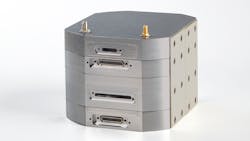Navy chooses Collins Aerospace to provide data link radio cryptographic modernization for smart munitions
PATUXENT RIVER NAS, Md. – U.S. Navy airborne weapons experts needed cryptographic modernization of a tactical data link radio designed to keep smart munitions on target. They found their solution from the Collins Aerospace segment of Raytheon Technologies Corp. in Cedar Rapids, Iowa.
Officials of the Naval Air Systems Command at Patuxent River Naval Air Station, Md., announced an $8.1 million order in late March to Collins Aerospace. Collins Aerospace became part of Raytheon Technologies earlier this year with the merger of United Technologies and the Raytheon Co.
The order provides for the cryptographic modernization of the Tactical Air Command Network 1.0 and 1.1 weapon data link radio for the Navy Harpoon Block II+, AGM-154 Joint Standoff Weapon (JSOW), and Small Diameter Bomb (SDB) Increment II smart munitions.
Harpoon Block II+ is an over-the-horizon anti-ship missile with an improved GPS guidance kit and a network-enabled data link that enables the missile to receive in-flight targeting updates.
The AGM-154 JSOW is a medium range precision guided glide bomb to attack defended targets from outside the range of standard anti-aircraft defenses.
Collins Aerospace designs and manufacturers the TacNet weapon data link to make guided weapons into network-enabled weapons. The weapon data radio provides weapon tracking, fire control, and situational awareness.
Related: Raytheon hardening SDB II smart munitions against electromagnetic jamming and cyber attack
The TacNet uses Link 16 and UHF waveforms to enable weapon inflight communications and controller handoff; provide inflight updates, retargeting, and abort functions; syncs with tactical networks in less than 12 seconds; and passive network sync to enhance performance in anti-access and area denial (A2/AD) environments.
The Collins Aerospace TacNet uses industry-standard interfaces to reduce integration and life cycle costs, as well as advanced NSA Type 1 programmable crypto to adapt to future threats.
On this order Collins Aerospace will do the work in Cedar Rapids, Iowa, and should be finished by December 2021. For more information contact Collins Aerospace online at www.collinsaerospace.com, or Naval Air Systems Command at www.navair.navy.mil.
About the Author
John Keller
Editor-in-Chief
John Keller is the Editor-in-Chief, Military & Aerospace Electronics Magazine--provides extensive coverage and analysis of enabling electronics and optoelectronic technologies in military, space and commercial aviation applications. John has been a member of the Military & Aerospace Electronics staff since 1989 and chief editor since 1995.

